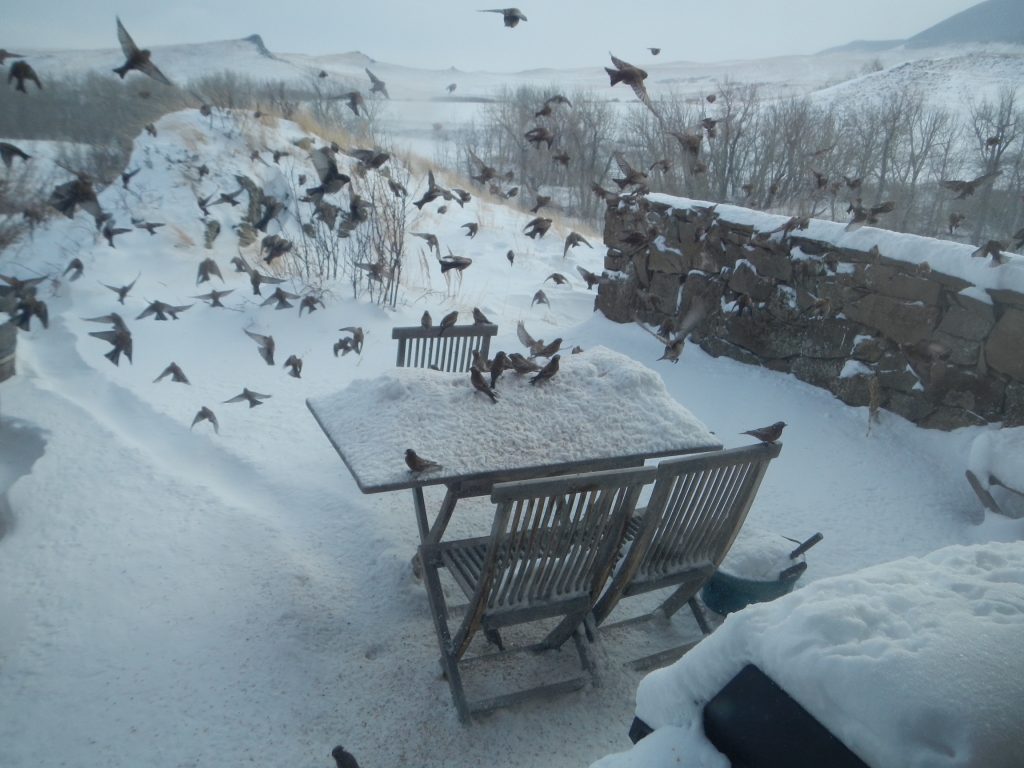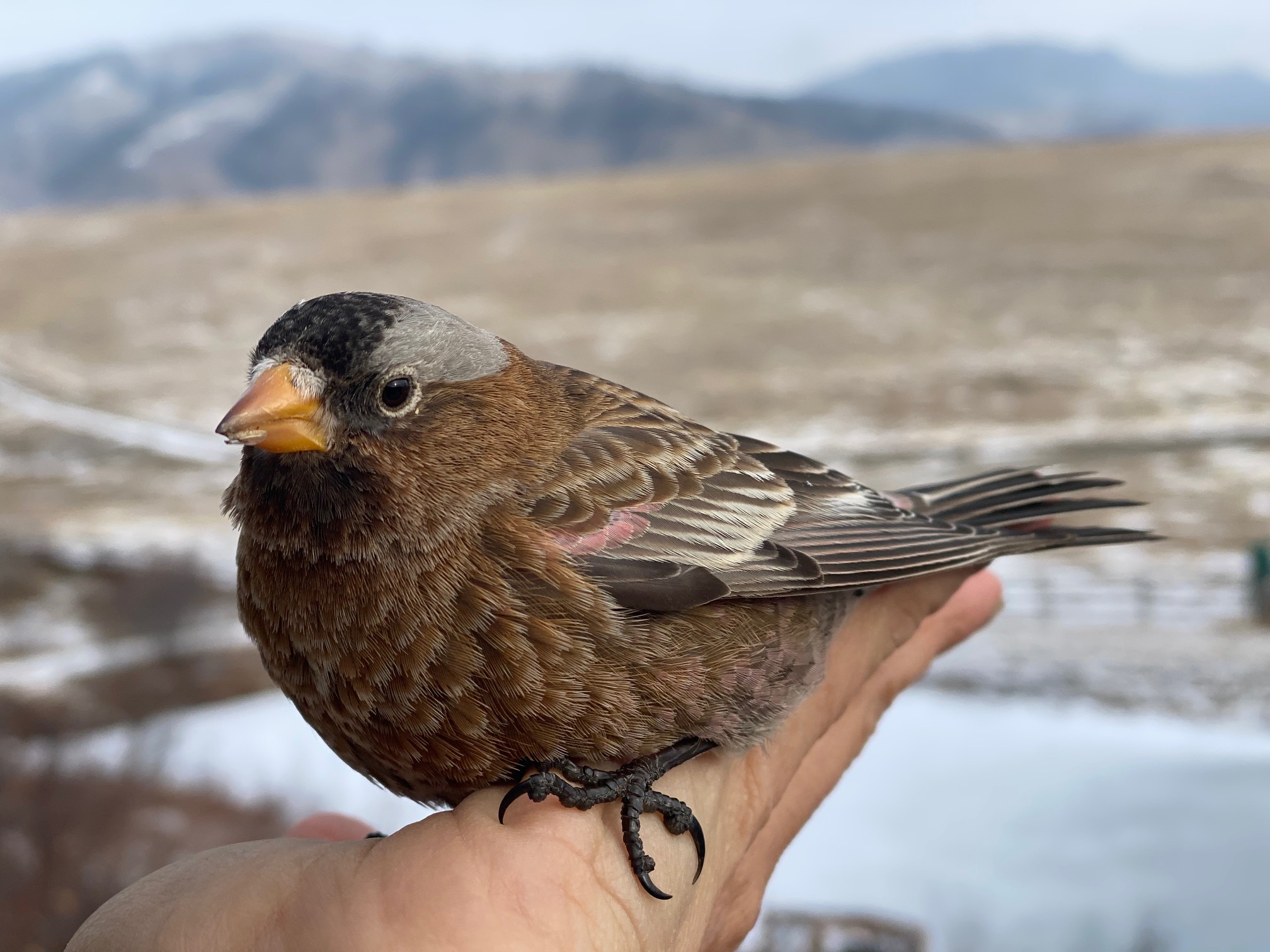Author Lynne Spriggs O’Connor: January 2021: As of January 1st, it seems our mountain valley in central Montana has had higher temperatures and less snowfall than usual. Only about 200 members of what was ultimately a 400+ flock last year have shown themselves so far. Only occasionally does this group arrive en masse at our kitchen porch for our offerings of thistle and black sunflower seeds. They seem relatively skittish; maybe more of these are youngsters? We’ve spotted smaller groups of 20-30 in flight down by the barn and guess they must still be feeding easily on their own. Our seasonal flock size typically keeps increasing from the time of first arrivals in November through this month of January. New groups sometimes arrive with big weather systems. Colder temperatures and snow typically settle in before February, when calving starts. Will more finches arrive? We’ve got plenty of seed to take care of them if they do.
Gray-crowned Rosy-Finches and I prefer similar environments. Our bodies are innately attracted to cooler temperatures at higher elevations. Creatures like us who inhabit mountain ecosystems gain temporary and relative respite from climate change. But those changes are intensifying in every part of our shared natural world. As the planet warms, birds and other wild species are moving upslope, apparently relocating to find the temperatures they’re accustomed and adapted to. The mountains around our valley rise to 7,000 feet. But no mountains rise up forever. What happens to the birds and other animals we care about – like our mountain goats, like these Rosy-Finches – who are already living at the top?
Recently, I’ve read about several studies of high-altitude birds and this predicament. One took place in Papua New Guinea. Retracing the footsteps of an expedition by Jared Diamond in the 1960’s, a Cornell graduate student named Ben Freeman compared a contemporary bird survey with data fifty years later. Freeman’s published research in 2014 showed that mountain birds there are shifting their ranges upslope in response to warming temperatures. In 1965, Diamond encountered Crested Berrypeckers on Mt. Karimui, a remote peak in New Guinea. He never saw these birds farther than forty feet below the summit. Nearly a half-century later, Crested Berrypeckers are recognized as one of four species on the verge of vanishing from Mt. Karimui. Freeman found that seventy percent of the species observed by Diamond had moved their ranges upslope by an average of 372 vertical feet. The average movement he discerned almost exactly matched the average rise in temperatures.
A second comparative study took place in Peru. In 1985, John Fitzpatrick hiked up a ridge called Cerro de Pantiacolla, in the Peruvian Andes, and found dozens of bird species living on the mountainside. The hazel-fronted pygmy-tyrant. The buff-browed foliage-gleaner. The fulvous-breasted flatbill. Thirty years later, the same Benjamin Freeman, now an ecologist at the University of British Columbia and a former student of Fitzpatrick’s, decided to retrace that same hike to determine if birdlife there had changed in the intervening decades. His discoveries were similar to what he documented in New Guinea: Peruvian mountaintop species in 2018 were retreating upslope and running out of mountain, even after just thirty years. Bird species were living an average of forty vertical meters (130 feet) higher up the mountain than they had in 1985. Upward shifts in ranges appeared across all types of birds—fruit eaters and insect eaters, ground foragers and canopy feeders, larger birds and smaller birds. The hazel-fronted pygmy-tyrant, the buff-browed foliage-gleaner, and the fulvous-breasted flatbill had all disappeared. Freeman and his co-authors summed up their findings: Mountain birds are “riding an escalator to extinction.”

In southeastern Canada and the Northeastern States, the Bicknell’s Thrush has already disappeared from Mount Greylock, the highest mountain in Massachusetts, and from portions of the Canadian Maritimes. Closer to home, wildlife biologist and rock climber Carl Brown initiated a study of Black Rosy-Finches in Wyoming. Each summer since 2016, high mountains from 10,000 to 14,000 feet have been scaled to observe nesting sites in crevices between rocks in near-vertical cliffs. This program’s investigations are establishing urgent baselines to monitor these high-altitude nesters who – like those in Papua New Guinea, Peru, and around the world – will likely experience the effects of climate change first and most harshly as species beneath them move “up the escalator.” “The most alarming part,” Brown says, “is the speed at which the change of habitat is quietly advancing.”
All three Rosy-Finches potentially are in trouble. Black and Brown-capped are fewer in number and their ranges are more southern, so these two southern species would be the first to be impacted. Gray-crowned are the most widespread in numbers and habitat and the most northern of the three species in North America. Even so, Audubon’s current 2020 online mapping of anticipation correlation with and consequences of rising temperatures for these high-altitude friends of mine is not encouraging.
Warm Chinook winds are blowing through our valley today, and I am thinking about how the lives of creatures become intertwined to create entire ecosystems of interdependence. I’m also contemplating what I read in an article published by Yale School of the Environment: “A shift in the range of a species can mean the loss of old partnerships, introduction of new rivalries, and the unraveling of entire ecosystems.” My husband and I know the wild creatures who live all around us as beloved members of a shared community. The appearance of exuberant Gray-crowned Rosy-Finches always brightens our day. These same birds will seek the fur of neighboring mountain goats when they make their nests on high northern mountain peaks in summer.
I cannot imagine the heartbreak of millions of people around the world who have lost a loved one to the coronavirus pandemic over this past year. So far, we have been lucky. But I feel acutely aware now of another clear and present danger: climate change. Suddenly, it has become personal. Its effects are threatening birds who visit us in stunning numbers from their world in the clouds. Who have kept us company each winter over the past fifteen years. My desire to continue learning about these intimate friends has forced me now to recognize them as a sentinel species. As poignant, high-altitude canaries. Everything about who Gray-crowned Rosy-Finches are and how they live keeps weaving the threads of my own life into the unspeakably beautiful, wild, and precarious nature of theirs.
Dr. Lynne Spriggs O’Connor is a writer and rancher. She has written several blogs here for FiRN named Finches of Cloudland, and her upcoming memoir is titled Elk Love: A Montana Memoir, where she writes about her special relationship with the Rosy-Finches that have visited her and her husband over the years.
FiRN is a nonprofit, and has been granted 501c3 status. FiRN is committed to researching and protecting these birds and other threatened finch species like the Evening Grosbeak and Rosy-finches, and if you have been enjoying all the blogs and identifying of Red Crossbill call types, redpoll subspecies and green morph Pine Siskins FiRN has helped with, please think about supporting our efforts and making a small donation at the donate link below.
REFERENCES
Diamond, J. M. 1972. Avifauna of the eastern highlands of New Guinea. Publications of the Nuttall Ornithological Club 12, Cambridge, MA. 438 pp.
Fair, Jeff. July 12, 2019. Audubon.org. As the Rockies Melt, This Rare Nesting Bird Will Have Nowhere to Go. This story originally ran in Audubon’s Summer 2019 issue as “A Slippery Slope for a Mountain Bird.”
Freeman, B. G., and A. M. Class Freeman. 2014. Rapid upslope shifts in New Guinean birds illustrate strong distributional responses of tropical montane species to global warming. Proceedings of the National Academy of Sciences 111 (12): 4490-4494. doi: 10.1073/ pnas.1318190111.
Freeman, B G., and Micah N. Scholer, Viviana Ruiz-Gutierrez, and John W. Fitzpatrick. PNAS November 20, 2018 115 (47) 11982-11987; first published October 29, 2018; Climate change causes upslope shifts and mountaintop extirpations in a tropical bird community. Edited by Alan Hastings, University of California, Davis, CA, and approved September 27, 2018 (received for review March 9, 2018)
For more on Finches of Cloudland and the Rosy-Finch Project, read below:
FiRN is a nonprofit, and has been granted 501c3 status. FiRN is committed to researching and protecting these birds and threatened finch species like the Evening Grosbeak, a species that has declined 92% since 1970. We are actively in the process of fundraising around an Evening Grosbeak Road to Recovery plan in addition to a student research project, so please think about supporting our efforts and making a small donation at the donate link below.

